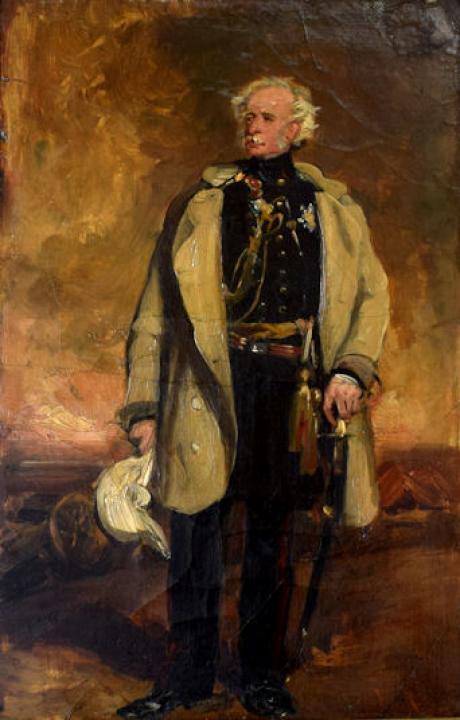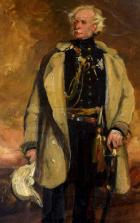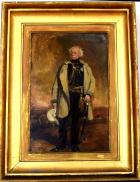on the reverse "Lord Gough by Sir F Grant PRA".
General Sir Hope Grant, (brother to Sir Francis Grant PRA) who would have known Gough well, died without children, it is possible that Francis Grant gave the porrait sketch to him.
By descent from the artist to his brother General Sir Hope Grant and then to Charles Grant of Kilgraston (Sir Francis Grant's nephew) and thence by descent to John Patrick Grant and then to Basil Brooke of Beil Estate
This portrait sketch is one of a number of working preparatory studies made for the full length portrait that hangs at the United Services Club owned by the Crown Commissioners. The full length portrait was exhibited in 1854, the other known study for this portrait is a pen and ink drawing made in 1853 and now in the National Portrait Gallery London. (NPG 805) showing Gough in a different pose, holding his trade mark hat in his left hand and pointing with his left hand. The mezzotint by S. Cousins published in or after 1866, (NPG D34648) shows the final version of the full length portrait where the artist has followed the pose outlined in the pen and ink study rather than this oil study.
Hugh Gough, , first Viscount Gough (1779–1869), army officer, was born on 3 November 1779 at Woodsdown, co. Limerick, Ireland, fourth son of George Gough of Woodsdown and his wife, Letitia, daughter of Thomas Bunbury of Lisnavagh and Moyle, co. Carlow. In 1793 he received a commission in the new Limerick city militia, of which his father was lieutenant-colonel, and on 7 August 1794 was promoted ensign in Hon. Robert Ward's regiment of foot, from which he was transferred in October to the 119th, of which he was adjutant at the age of fifteen. On 6 June 1795 he was promoted lieutenant in the 78th Highlanders, on the formation of its 2nd battalion, and was present with it at the capture of the Cape of Good Hope that year, and at the surrender of the Dutch fleet in Saldanha Bay in 1796. His friends had meanwhile procured his transfer to the 87th Prince of Wales's Irish, with which he served against the brigands in St Lucia, at the capture of Trinidad, the attack on Puerto Rico, and the capture of Surinam, serving with it in the West Indies and at Curaçoa until 1803. In 1803 he obtained command of a company in a second battalion of the regiment formed at Frome, Somerset, by Sir Charles William Doyle from men enrolled in the army of reserve in the counties of Tipperary and Galway. Gough became major in the battalion in 1805, and in 1807 he married Frances Maria, daughter of General Edward Stephens, Royal Artillery. They had a son, the second viscount, and four daughters. Lady Gough died in 1863.
Doyle having been sent to Spain, Gough commanded the battalion when it embarked for Portugal on 28 December 1808, and at the battle of Talavera on 28 July 1809, where the ‘Faugh a Ballaghs’ (‘Clear the Ways’), as this regiment was called from its Irish battle-cry, sustained heavy losses. Gough was severely wounded, and had his horse shot under him. At Wellington's request Gough's commission as lieutenant-colonel was antedated to the battle, the first British officer to receive brevet promotion in action at the head of a regiment. In 1810 the battalion was with Graham at Cadiz, and formed part of the force that disembarked at Algeciras, and fought the battle of Barossa on 5 March 1811, when Gough, with the 87th and three companies 1st guards, made a famous charge on the French 8th light infantry. An ‘eagle’—the first taken in the Peninsular War—was captured by Sergeant Patrick Masterson of the 87th, and an eagle with collar of gold and the figure 8 was thereafter worn as a badge of honour by the regiment. Graham wrote to its colonel: ‘Your regiment has covered itself with glory’ (Cannon, 52). The battalion afterwards went to Cadiz and Gibraltar, and in October 1811 to Tarifa, and, when the French under Laval attacked, it defended the breach in the south-east front. In a desperate assault on 31 October 1811 the heroic leader of the French fell, dying against the portcullis which closed the breach, yielding his sword to Gough through the bars. An open breach between two turrets, with the British colours flying, and the word Tarifa, are among the augmentations to the Gough family arms.
The battalion with Gough in command joined Wellington's army in October 1812, and fought at the battle of Vitoria and in the subsequent campaigns. Gough was disabled by a severe wound received at the battle of Nivelle on 10 November 1813. His application for a company in the guards was unsuccessful. He was knighted at Carlton House on 4 June 1815 and received the freedom of the city of Dublin. He was in command of the 2nd 87th when it was disbanded in February 1817. Gough remained on half pay until 1819, when he was appointed to the 22nd foot, and commanded it most of the time in the south of Ireland during a period of civil unrest, until 1826. He then again retired on half pay. When not in regimental employment he was chiefly on his estate in co. Tipperary, where he was a magistrate and popular with the gentry.
Gough became a major-general in 1830, was made KCB in 1831, and in 1837 appointed to command the Mysore division of the Madras army. In the First Opium War Gough was sent to command the troops at Canton (Guangzhou), where he arrived on 2 March 1841. The forts defending Canton were captured on 26–7 May 1841, and Gough was made GCB. After the arrival of Admiral Sir William Parker in July, Gough commanded the troops in the combined operations which ended with the capture of the great fortified city of Chinkiang (Zhenjiang) and the signing of the treaty at Nanking (Nanjing) in 1842. For his part in these events Gough was created a baronet, and received the thanks of parliament and of the East India Company. He returned to Madras, having been made presidency commander-in-chief on 16 June 1841, and on 11 August 1843 was appointed commander-in-chief in India.
Soon after his arrival in Bengal, Gough assumed command of the ‘army of exercise’ assembled at Agra in view of difficulties over the Gwalior succession. The army entered that state and firm government was established there, but this was unpopular with the Maratha army. Conflict with it appearing inevitable, the Maratha army was attacked and routed by Gough at Maharajpur on 29 December 1843, suffering heavy loss. Gough was again thanked by parliament. Lord Ellenborough, then governor-general, apparently doubted Gough's fitness for the command. He wrote to Wellington on 20 April 1844, just before his own removal, that Gough, ‘despite his many excellent qualities, had not the grasp of mind and the prudence essential to conduct great military operations’ (Indian Administration, 435).
On 11 December 1845 Sikhs invaded the company's territory, starting the First Anglo-Sikh War. Gough, loyally supported by Hardinge, the new governor-general, who placed himself under Gough's orders as second in command, defeated the invaders by sheer hard fighting at Mudki, Ferozeshahr, and Sobraon, and was able to dictate terms to the Sikhs. He was then raised to the peerage as Baron Gough of Ching-keang-foo (Qingjiangfu), China, Maharajpur, and the Sutlej in the East Indies. In the Second Anglo-Sikh War three years later Gough defeated the enemy at Ramnagar, and again on 13 January 1849 at Chilianwala—a victory, despite heavy losses, which contributed to the destruction of Sikh power. The severe loss at Chilianwala has been attributed to the failure of a subordinate, but Gough's failure to reconnoitre the Sikhs' position properly before attacking was also blameworthy. When the news reached Britain there was a public outcry against him and his ‘Tipperary tactics’. Gough made no public response. The presence on the battlefield of the governor-general at Mudki, Ferozeshahr, and Sobraon must have added to Gough's problems, for Hardinge, also a soldier, had made himself second in command. He largely shared Ellenborough's doubts as to Gough's fitness for command and was greatly disturbed by the casualties incurred. After Sobraon, Hardinge wrote: ‘sometimes I am almost in despair at his want of method & combination & discipline. He has a great many fine qualities of bravery & kindness of heart & is a gentleman but is very jealous’ (Letters, 146). Sir Charles Napier was sent out to supersede him, but before the change could take place Gough had re-established his reputation by his crushing defeat of the Sikh armies at Gujrat on 21 February 1849, followed by their unconditional surrender to the pursuing force under General Gilbert. He vacated the command on 7 May 1849.
On his return to England, Gough was made a viscount, and awarded a pension of £2000 a year to himself and the next two heirs to the title. The East India Company voted him thanks and a pension, and the City of London conferred its freedom on him. He became a full general in 1854, and was appointed colonel-in-chief of the 60th rifles. He was made colonel of the Royal Horse Guards in 1855. In 1856 he was sent to Sevastopol to invest Marshal Pélissier and other officers with the insignia of the Bath. In 1857 he was made KP (the first non-Irish peer to be such). In 1859 he was sworn of the privy council and in 1861 was made GCSI. On 9 November 1862 he became field marshal. In politics he was a Conservative.
Gough, a man of noble presence, was said to have commanded in more general actions than any other British officer of the nineteenth century except the duke of Wellington. His courage, chivalry, and racy brogue all contributed to his popularity with his soldiers, despite his bull-headed tactics. Wellington described him as ‘affording the brightest example of the highest qualities of the British soldier’ (Fortescue, Brit. army, 12.473). He could however be vindictive, as was shown by his harsh treatment of Henry Havelock after the Anglo-Sikh wars. Gough died at his seat, St Helens, near Booterstown, co. Dublin, on 2 March 1869, and was buried on 9 March at Stillorgan.
H. M. Chichester, rev. James Lunt DNB
Grant, Sir Francis (1803–1878), portrait and sporting painter, was born on 18 January 1803 in Edinburgh, the fourth of seven children of Francis Grant (d. 1819), laird of Kilgraston, Perthshire, a landowner with estates in Scotland and Jamaica, and his wife, Anne Oliphant. His brother was General Sir James Hope Grant (1808–1875). From the age of eleven to thirteen, Francis Grant attended Harrow School, and he finished his education at Edinburgh high school in 1818. Sir Walter Scott left the following account of the young Francis Grant in his journal of 1831:
In youth, that is extreme youth, he was passionately fond of fox-hunting and other sports … He also had a strong passion for painting, and made a little collection. As he had enough sense to feel that a younger brother's fortune would not last long under the expenses of a good stud and a rare collection of chef-d'œuvres, he used to avow his intention to spend his patrimony, about £10,000, and then again to make his fortune by the law. The first he soon accomplished. But the law is not a profession so easily acquired, nor did Frank's talents lie in that direction. His passion for painting turned out better. (Journal, 802–3)
Grant did study for the Scottish bar for one year, but he soon decided to make a career as an artist. In 1826 Grant married Amelia Farquharson, the daughter of a Scottish laird; Amelia died in 1827, after the birth of their son. Grant's second wife, Isabella Elizabeth Norman, whom he married in 1829, gave birth to three sons and four daughters during the course of their marriage. Isabella was a niece of the duke of Rutland, the leader of hunting society at Melton Mowbray, Leicestershire. Grant had frequented the hunts at Melton Mowbray since 1820, where he became acquainted with the sporting artist John Ferneley. He studied painting briefly with Ferneley, and possibly with Alexander Nasmyth in Edinburgh.
Grant's second marriage gave him access to many clients among the hunting set in Melton Mowbray, and his first successes were sporting pictures such as A Meet of the Fife Hounds(1833; Scot. NPG). In 1834 Grant's The Melton Breakfast (priv. coll.) was shown at the Royal Academy, and proved extremely popular as an engraving. In 1837 The Meeting of his Majesty's Staghounds on Ascot Heath (ex Christies, 31 May 1918) was accepted to the Royal Academy exhibition, and in 1855 it was awarded a gold medal at the Universal Exhibition in Paris. Grant's next major sporting picture, The Melton Hunt Going to Draw the Ram's Head Cover (exh. RA, 1839; Virginia Museum of Fine Arts), was praised for its accurate portrayal of thirty-six different riders, as well as its lively and varied composition. Unlike his earlier cabinet-sized hunting scenes, The Melton Hunt Going to Draw featured life-size figures in motion. In 1840, Grant received a commission to paint Queen Victoria. His Queen Victoria Riding out (exh. RA, 1840; Royal Collection) shows the queen taking exercise in Windsor Great Park with members of her household. Victoria's diaries provide an invaluable account of the process by which he painted such large, multi-figure equestrian portraits. Grant generally painted the horses in his studio, which was equipped for live animals. For the portraits, he often posed his sitters astride a wooden horse, and the queen described Lord Melbourne sitting to Grant ‘on that wooden horse without head or tail, looking so funny, his white hat on, an umbrella in lieu of a stick’ (Millar, 84). Many years later Willoughby de Broke contrasted his paintings favourably with photographs: the great painter of the English gentry, ‘he was of their class; he knew how a well-bred man ought to sit on a well-bred horse, and he put him there, as few other artists ever could, plumb on the middle of the saddle’ (Broke, 11).
The success of Queen Victoria Riding out allowed Grant to concentrate primarily on portraiture, as opposed to sporting painting, after 1840. Grant's success in this genre was unmatched by his contemporaries. The portraits he produced in the latter half of his career are notable for their large scale and broad brushwork, anticipating trends in later Victorian and Edwardian portraiture. He painted many of the famous figures of his day, including Queen Victoria and Prince Albert, in equestrian portraits for Christ's Hospital, London (exh. RA, 1846; governors of Christ's Hospital, London), Henry Hardinge, first Viscount Hardinge of Lahore (exh. RA, 1850; NPG), Benjamin Disraeli (exh. RA, 1852), Edwin Landseer (c.1852; NPG), John Russell, first Earl Russell (1853; NPG), and Thomas Babington Macaulay, Baron Macaulay (1853; NPG). Grant's success was often attributed to his good looks and aristocratic background, but his popularity was more probably due to the fact that he tempered the heroic intensity of Thomas Lawrence's windswept, Romantic portraits with a dose of Victorian sobriety, while never forsaking gentle idealization of the face and figure of his sitter. His style complemented perfectly the aristocratic collections of his patrons, which often contained works by Van Dyck, Gainsborough, and Thomas Lawrence. Grant's portraits of women were particularly popular and well received. Important examples include The Daughters of the Duke of Norfolk (exh. RA, 1848; priv. coll.) and Louise, Marchioness of Waterford (1857; NPG). His most experimental portraits, such as Daisy Grant (exh. RA, 1857; NG Scot.) and Elizabeth Grant (1851; RA), portray his own daughters.
Grant was also a distinguished and influential member of the Royal Academy. In 1866, after his friend Edwin Landseer declined the position, Grant was elected president of the Royal Academy; that same year he was knighted. As president, he negotiated the Royal Academy's 999-year lease on Burlington House, Piccadilly, London, for the rate of £1 a year, and oversaw its renovation. Grant introduced honorary memberships in 1868, and instituted the annual winter loan exhibition in 1870. According to Francis Frith,
For ‘dear old Grant’, as we always called him, every member of the Academy … had the warmest affection … There was a rollicking, foxhunting kind of flavour about his speeches, he leapt over art questions, and just shook his whip at the students, or at the shortcoming of the exhibition. (Wills, ‘Sir Francis Grant as a sporting painter’)
Some critics accused Grant of promoting the interests of portraiture at the expense of other genres. In 1868 Grant lifted the ban on whole-length and half-length portraits being hung at eye level, or ‘on the line’, in the exhibition galleries. According to G. D. Leslie, ‘Coincidentally with the invasion of the line by the life-sized portraits, the patronage hitherto given to subject-pictures began to fall lamentably, and in consequence of this a great number of distinguished painters, who formerly produced important works of figure subjects, began to take to portraiture’ (B. Denvir, ed., The Late Victorians: Art, Design and Society, 1852–1910, 1986, 35).
After several years of failing health Grant died of heart disease at his country home, The Lodge, at Melton Mowbray, on 5 October 1878. Grant's family declined the honour of interment at St Paul's Cathedral, and Grant was buried on 12 October 1878 in the Church of England cemetery at Melton Mowbray, Leicestershire. He was survived by his wife.
A. Cassandra Albinson DNB



